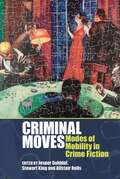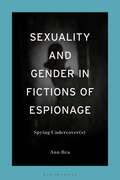- Table View
- List View
Criminal Moves: Modes of Mobility in Crime Fiction (Liverpool English Texts and Studies #78)
Criminal Moves: Modes of Mobility in Crime Fiction offers a major intervention into contemporary theoretical debates about crime fiction. It seeks to overturn the following preconceptions: that the genre does not warrant critical analysis, that genre norms and conventions matter more than textual individuality, and that comparative perspectives are secondary to the study of the British-American canon. Criminal Moves challenges the distinction between literary and popular fiction and proposes that crime fiction be seen as constantly violating its own boundaries. Centred on three axes of mobility, the essays ask how can we imagine a mobile reading practice that realizes the genre’s full textual complexity, without being limited by the authoritative self-interpretations provided by crime narratives; how we can overcome restrictive notions of ‘genre’, ‘formula’ or ‘popular’; and how we can establish transnational perspectives that challenge the centrality of the British-American tradition and recognize that the global history of crime fiction is characterized, not by the existence of parallel national traditions, but rather by processes of appropriation and transculturation. Criminal Moves presents a comprehensive reinterpretation of the history of the genre that also has profound ramifications for how we read individual crime fiction texts.
Hardboiled: An Anthology of American Crime Stories
What are the ingredients of a hard-boiled detective story? "Savagery, style, sophistication, sleuthing and sex," said Ellery Queen. Often a desperate blond, a jealous husband, and, of course, a tough-but-tender P.I. the likes of Sam Spade or Philop Marlowe. Perhaps Raymond Chandler summed it up best in his description of Dashiell Hammett's style: "Hammett gave murder back to the kind of people that commit it....He put these people down on paper as they were, and he made them talk and think in the language they customarily used for these purposes." Hard-Boiled: An Anthology of American Crime Stories is the largest and most comprehensive collection of its kind, with over half of the stories never published before in book form. Included are thirty-six sublimely suspenseful stories that chronicle the evolutiuon of this quintessentially American art form, from its earliest beginnings during the Golden Age of the legendary pulp magazine Black Mask in the 1920s, to the arrival of the tough digest Manhunt in the 1950s, and finally leading up to present-day hard-boiled stories by such writers as James Ellroy. Here are eight decades worth of the best writing about betrayal, murder, and mayhem: from Hammett's 1925 tour de force "The Scorched Face," in which the disappearance of two sisters leads Hammett's never-named detective, the Continental Op, straight into a web of sexual blackmail amidst the West Coast elite, to Ed Gorman's 1992 "The Long Silence After," a gripping and powerful rendezvous involving a middle class insurance executive, a Chicago streetwalker, and a loaded .38. Other delectable contributions include "Brush Fire" by James M. Cain, author of The Postman Always Rings Twice, Raymond Chandler's "I'll Be Waiting," where, for once, the femme fatale is not blond but a redhead, a Ross Macdonald mystery starring Macdonald's most famous creation, the cryptic Lew Archer, and "The Screen Test of Mike Hammer" by the one and only Micky Spillane. The hard-boiled cult has more in common with the legendary lawmen of the Wild West than with the gentleman and lady sleuths of traditional drawing room mysteries, and this direct line of descent is on brilliant display in two of the most subtle and tautly written stories in the collection, Elmore Leonard's "3:10 to Yuma" and John D. MacDonald's "Nor Iron Bars." Other contributors include Evan Hunter (better known as Ed McBain), Jim Thompson, Helen Nielsen, Margaret Maron, Andrew Vachss, Faye Kellerman, and Lawrence Block. Compellingly and compulsively readable, Hard-Boiled: An Anthology of American Crime Stories is a page-turner no mystery lover will want to be without. Containing many notable rarities, it celebrates a genre that has profoundly shaped not only American literature and film, but how we see our heroes and oursleves.
Noir in the North: Genre, Politics and Place
What is often termed 'Nordic Noir' has dominated detective fiction, film and television internationally for over two decades. But what are the parameters of this genre, both historically and geographically? What is noirish and what is northern about Nordic noir? The foreword and coda in this volume, by two internationally-bestselling writers of crime fiction in the north, Yrsa Sigurðardóttir and Gunnar Staalesen, speak to the social contract undertaken by writers of noir, while the interview with the renowned crime writer Val McDermid adds nuance to our understanding of what it is to write noir in the North.Divided into four sections – Gender and Sexuality, Space and Place, Politics and Crime, and Genre and Genealogy – Noir in the North challenges the traditional critical histories of noir by investigating how it functions transnationally beyond the geographical borders of Scandinavia. The essays in this book deepen our critical understanding of noir more generally by demonstrating, for example, Nordic noir's connection to fin-de-siècle literatures and to mid-century interior design, and by investigating the function of the state in crime fiction.
Sexuality and Gender in Fictions of Espionage: Spying Undercover(s)
An exploration of how espionage narratives give access to cultural conceptions of gender and sexuality before and following the Second World War, this book moves away from masculinist assumptions of the genre to offer an integrative survey of the sexualities on display from important characters across spy fiction. Topics covered include how authors mocked the traditional spy genre; James Bond as a symbol of pervasive British Superiority still anxious about masculinity; how older female spies act as queer figures that disturb the masculine mythology of the secret agent; and how the clandestine lives of agents described ways to encode queer communities under threat from fascism. Covering texts such as the Bond novels, John Le Carré's oeuvre (and their notable adaptations) and works by Helen MacInnes, Christopher Isherwood and Mick Herron, Sexuality and Gender in Fictions of Espionage takes stock of spy fiction written by women, female protagonists written by men, and probes the representations of masculinity generated by male authors. Offering a counterpoint to a genre traditionally viewed as male-centric, Sexuality and Gender in Fictions of Espionage proposes a revision of masculinity, femininity, queer identities and gendered concepts such as domesticity, and relates them to notions of nationality and the defence work conducted at crucial moments in history.



